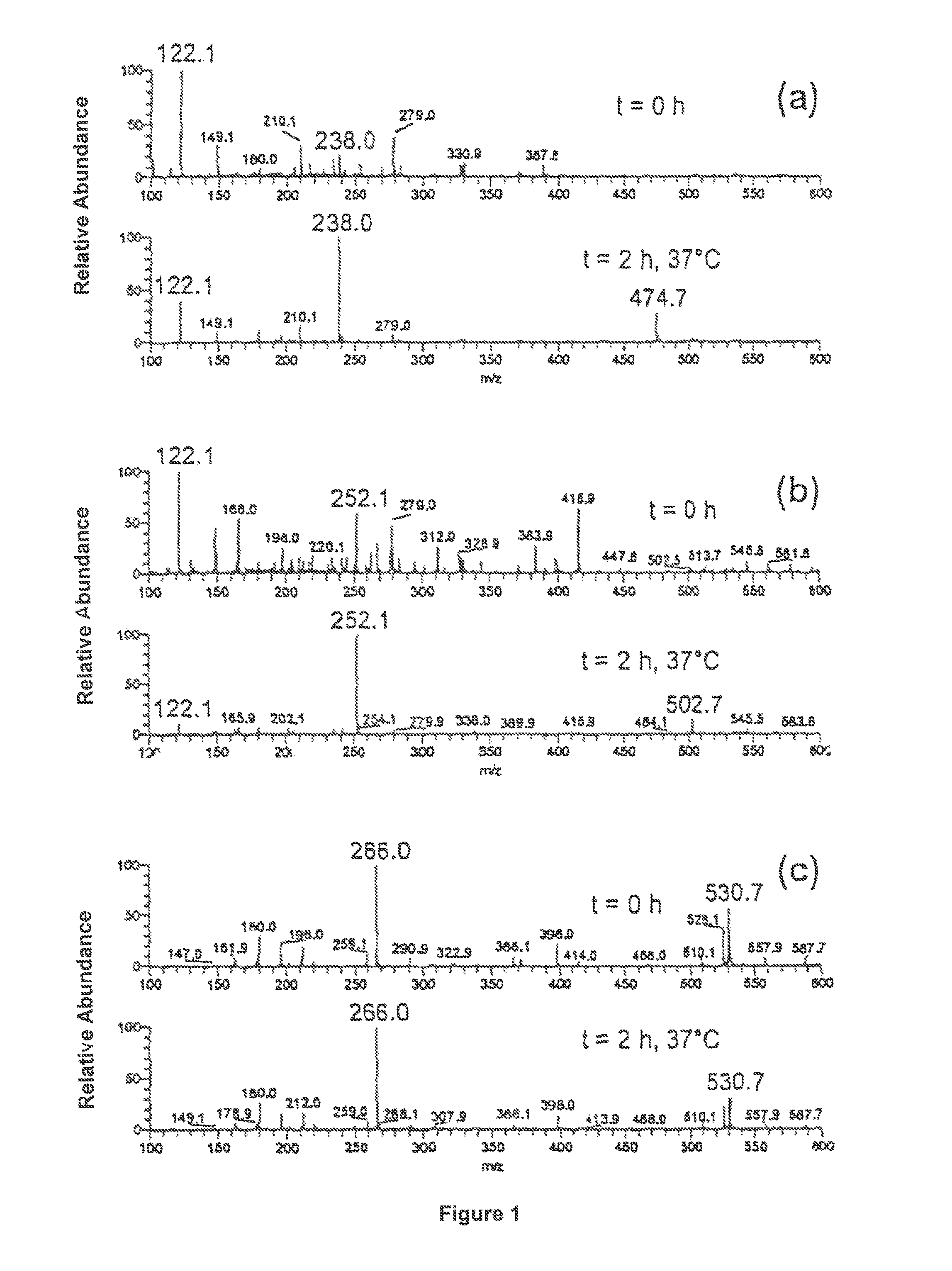Thiosuccinic acid derivatives and the use thereof
a technology of thiosuccinic acid and derivatives, which is applied in the field of thiosuccinic acid derivatives, can solve the problems of reddening, gastrointestinal irritation, and the disadvantage of fumaric acid esters, which are difficult to handle in the preparation of pharmaceutical products, and are known side effects of fumaric acid therapy
- Summary
- Abstract
- Description
- Claims
- Application Information
AI Technical Summary
Benefits of technology
Problems solved by technology
Method used
Image
Examples
example 1
[0101]A tenfold excess of a fumaric acid derivative A is mixed with a 0.01 M aqueous ammonium acetate solution at a pH of 7.4 and a 0.001 M thiol solution B at 37° C. Immediately after mixing and after two hours of stirring, a mass spectrum was taken. The fumaric acid derivatives and thiols, respectively, and the products to be expected are shown in table 1. The mass spectra recorded are shown in FIG. 1 and FIG. 2
[0102]All mass spectra were recorded by means of a LCQ Ion Trap mass spectrometer (Finnigan MAT, USA) equipped with an electrospray ioniser (ESI) and a chemical atmospheric pressure ionising interface (APCI), and a Reflex IV Time-of-Flight (TOF) mass spectrometer (Bruker, Germany) equipped with a matrix-supported laser desorption / ionisation (MALDI).
[0103]
TABLE 1Exam-pleMSNo.ABProductspectrum1FA1)Cysteineα-Cysteine-S-yl succinic acid1a, 2a2MHF2)CysteineMethyl-α-cysteine-S-yl1b, 2bsuccinic acid ester3DMF3)CysteineDimethyl-α-cysteine-S-yl1c, 2csuccinic acid ester4DMFGRGPeptide...
example 2
[0106]In order to rule out the possibility that the products of the interaction between the fumaric acid derivative and cysteine or the cysteine-containing peptide were generated during ionisation in the ion source, two control experiments were carried out.
[0107]In a first experiment, the solutions of cysteine or glutathion, respectively, were mixed with dimethyl fumarate and the time dependence of the increase or decrease of the reaction feedstock and products observed by flow injection analysis. For this purpose, samples were taken from each of the reaction mixtures of example 1 and injected into the carrier liquid stream and the ion source. The surfaces of the quasimolecular ion peaks were recorded as percent of the sum of the two compounds tracked vs. time. The result is shown in FIG. 3. It confirms the addition in solution. The spectra also confirm that the thiol group is added to the double bond of the fumaric acid.
example 3
Dimethyl-2-(glutathione-S-yl)succinate
[0108]Glutathione (1 eq.) is dissolved in water and the pH value adjusted to 7.4 (with triethyl amine or ammonium acetate).
[0109]Dimethyl fumarate (1 eq.) dissolved in acetone is added over 20 to 30 minutes at approx. 40° C. The solution is stirred further over night and the solvent then distilled off or lyophilised, respectively. The residue is subjected to analysis and processed into the corresponding product.
ESI-MS-MS:
[0110]pos. ion mode: 490 [M+K]+ (80); 474 [M+Na]+ (100); 452 (M+H]+ (78)[0111]neg. ion mode: 901 [2M−H]− (5), 450 [M−H]− (100); 306 [M−(DMF+H)]− (20)
PUM
| Property | Measurement | Unit |
|---|---|---|
| diameter | aaaaa | aaaaa |
| diameter | aaaaa | aaaaa |
| pH | aaaaa | aaaaa |
Abstract
Description
Claims
Application Information
 Login to View More
Login to View More - R&D
- Intellectual Property
- Life Sciences
- Materials
- Tech Scout
- Unparalleled Data Quality
- Higher Quality Content
- 60% Fewer Hallucinations
Browse by: Latest US Patents, China's latest patents, Technical Efficacy Thesaurus, Application Domain, Technology Topic, Popular Technical Reports.
© 2025 PatSnap. All rights reserved.Legal|Privacy policy|Modern Slavery Act Transparency Statement|Sitemap|About US| Contact US: help@patsnap.com



